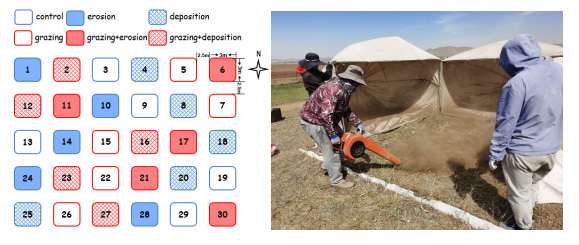Scientific Question
Grasslands account for 37% of the Earth’s land area and 69% of the agricultural area worldwide and play a vital role in ensuring global food security via continuous provision of ecological goods and services. Grazing can play a crucial role in regulating grassland plant community composition and structure, with subsequent effects on ecosystem functioning and services. Selective foraging by grazing animals can influence plant communities directly by defoliation and changing interspecific competition, and indirectly by modulating light availability. For example, livestock foraging may suppress species dominating in the canopy layer with higher competitiveness for light, and thus increase light availability for sub-canopy specie.
In addition to the direct impacts of grazing on grassland plant communities, defoliation and trampling by grazing animals may increase the wind erodibility of grassland soils, especially in arid and semi-arid regions, for several reasons. First, livestock trampling can destroy soil crusts, compact the topsoil, and decrease water infiltration rate and soil stability. Second, the expansion of bare soil areas associated with livestock trampling and the losses of standing vegetation under grazing may create greater wind flow along the soil surface and consequently higher wind speeds, providing favourable conditions for the occurrence of dust emission events.
Wind erosion of soils can result in the loss of fine sediments, mainly silt/clay and fine sand, and associated nutrients such as nitrogen by blowing off the most fertile topsoil. This may alter plant community composition by accelerating shrub expansion and increasing the dominance of plant species with high nutrient-use efficiency. Contrary to the impacts of wind erosion, dust deposition may provide additional nutrients for plant growth, which may, in turn, lead to changes in interspecific competition and trade-offs, thus affecting plant community composition and diversity. For example, it has been documented that nutrient enrichment could enhance the dominance of plant species with high competitiveness for light and thus decrease species richness.
Nevertheless, how wind erosion and dust deposition in combination with grazing affect grassland plant communities remain unexplored at the regional and global scales, which may further limit our understanding of grassland community variability and consequent carbon cycling in the source area under grassland management practices and dust disasters. To examine the responses of plant community structure and carbon cycle to grazing and simulated aeolian processes (i.e., wind erosion and dust deposition), the Laboratory of Global Change Ecology established a field experiment manipulating grazing and aeolian processes in a semi-arid temperate steppe on the Mongolian Plateau, China.
Experimental Design
This experiment was established in April 2010 and manipulatied two factors: grazing and aeolian processes, which had two (without and with grazing) and three levels (control, wind erosion, and dust deposition), respectively. A randomized complete block design was used involving six treatments including a control (C), wind erosion (WE), dust deposition (DD), grazing (G), wind erosion plus grazing (WE+G), and dust deposition plus grazing (DD+G). Each treatment had five replicates. There was a 1.5-m buffer zone between any two adjacent 4-m × 4-m plots (see Fig. 2A and B for experimental layout). Each plot had a 3-m × 3-m central area for measurements to avoid any possible edge effect.
In each grazed plot, a one-year old sheep was used to forage for four hours per month from June to September each year from 2010 to 2019. Aeolian processes were simulated in early May of each year. A 1-cm layer of topsoil was blown off using a portable pneumatic extinguisher (Taining Machinery Ltd. Co., Taizhou, Jiangsu, China) to mimic wind erosion. During the wind erosion simulations, we collected soil blown off from the wind erosion plots with a cloth bag. The collected soil was sieved using a 5-mm mesh to remove litters, mixed, and spread evenly on the surface of the dust deposition plots to mimic dust deposition.

实验人员
池振生


